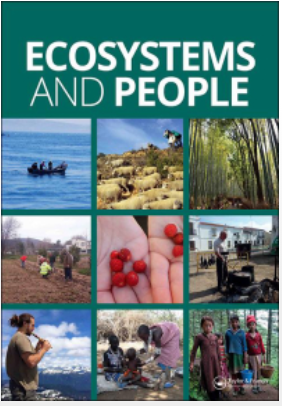在干涸的河流中共同创造自然对人类的贡献:西班牙穆尔西亚的案例研究
IF 3.7
Q1 Agricultural and Biological Sciences
引用次数: 0
摘要
摘要 干流是指除暴雨或融雪后河道中没有地表水的非常年性河流。缺乏水流通常与自然对人类的贡献(NCP)较低和生活质量较差有关。然而,最近的审查研究发现,有证据表明人类社区通过共同创造多种 NCP 而在干涸的河流中繁荣发展,尽管尚未有案例研究证实这一证据。我们评估了干涸河流及其相关社会系统提供 NCP 的能力。我们在穆尔西亚(西班牙)最干旱的地区选择了三条具有较高自然、文化和景观价值的干涸河流。我们采访了研究地区最有影响力的社会团体的 37 名代表,以探讨干涸河流的 NCP 及其协同作用和权衡。我们确定了四种物质性、三种非物质性和八种调节性 NCP,以及一种独特的 NCP:通过干涸河床进入村庄和田地。确定了 52 项协同作用,特别是物质性和非物质性国家协调计划之间的协同作用,以及 8 项权衡作用。这种广泛的非物质文化遗产和协同作用是干涸河流与社会系统之间共同生产过程的结果。社会系统世代相传的关于洪水管理、生物多样性和地质多样性的本土和地方知识似乎是国家合作计划共同生产的基础。将这些知识纳入研究和管理有助于提高人们对干流所提供的国家保护计划的认识,并有助于制定减缓和适应全球变化的战略。主要政策亮点 干流提供的益处有助于提高人们的生活质量。这些效益是由干流及其相关社会系统共同创造的。利益的共同创造取决于社会系统世代相传的传统知识。干流及其社会系统之间的利益共同生产是一种可持续的参考模式,可提供食物、淡水、药品、建筑材料、自然栖息地、土壤保护、科学进步、娱乐和文化认同。来自干流的利益共同生产和传统知识不仅有助于提高人们的生活质量,也是应对全球变化,特别是干地气候变化的战略来源。社会似乎没有意识到干涸河流对我们生活质量的重要价值。将利益共同生产和传统知识纳入治理对于重新评估这些生态系统的价值和制定有效的管理政策至关重要。本文章由计算机程序翻译,如有差异,请以英文原文为准。
Co-production of nature’s contributions to people in dry rivers: a case study in Murcia, Spain
ABSTRACT Dry rivers are non-perennial rivers with no surface water in their channels except after heavy rainfall or snowmelt. The lack of water flow is often associated with a low provision of Nature’s Contributions to People (NCP) and a poor quality of life. However, recent review studies have found evidence of human communities thriving in dry rivers through the co-production of multiple NCP, although no case studies have yet confirmed this evidence. We assessed the capacity of dry rivers and their associated social systems to provide NCP. We selected three dry rivers with high natural, cultural and landscape values in the most arid part of Murcia (Spain). We interviewed 37 representatives of the most influential social groups in the study area to explore the NCP of dry rivers, their synergies and trade-offs. Four material, three non-material and eight regulating NCP were identified, as well as one unique NCP: access to villages and fields through dry riverbeds. Fifty-two synergies were identified, especially between material and non-material NCP, and eight trade-offs. This wide range of NCP and synergies is a consequence of the co-production processes between dry rivers and the social system. NCP co-production seems to be underpinned by the indigenous and local knowledge acquired by the social system over generations about the management of floodwaters, biodiversity and geodiversity. Incorporating this knowledge into research and governance can help raise awareness of the NCP provided by dry rivers and help develop strategies for mitigating and adapting to global change. Key policy highlights Dry rivers provide benefits that contribute to people’s quality of life. These benefits are co-produced by dry rivers and their associated social systems. The co-production of benefits depends on the traditional knowledge that social systems have acquired over generations. The co-production of benefits between dry rivers and their social systems is a sustainable reference model, providing food, freshwater, medicines, building materials, natural habitats, soil protection, scientific advances, recreation and cultural identity. Benefit co-production and traditional knowledge from dry rivers not only contribute to people’s quality of life, but are also a source of strategies for coping with global change, particularly climate change in drylands. Society seems to be unaware of the high value of dry rivers for our quality of life. Integrating benefit co-production and traditional knowledge into governance is essential to revalue these ecosystems and develop effective management policies.
求助全文
通过发布文献求助,成功后即可免费获取论文全文。
去求助
来源期刊

Ecosystems and People
Agricultural and Biological Sciences-Ecology, Evolution, Behavior and Systematics
CiteScore
7.80
自引率
11.30%
发文量
40
审稿时长
42 weeks
期刊介绍:
Ecosystems and People is an interdisciplinary journal that addresses how biodiversity and ecosystems underpin human quality of life, and how societal activities and preferences drive changes in ecosystems. Research published in Ecosystems and People addresses human-nature relationships and social-ecological systems in a broad sense. This embraces research on biodiversity, ecosystem services, their contributions to quality of life, implications for equity and justice, and the diverse and rich ways in which people relate to nature.
 求助内容:
求助内容: 应助结果提醒方式:
应助结果提醒方式:


